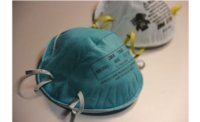From NIOSH
N95 Day 2017: When to think beyond the N95 FFR

By Margaret Sietsema, PhD, and Jaclyn Krah Cichowicz, MA
Buckle your seat belts! Put on your high-speed safety gear! We’re about to blast off on a journey to explore the N95 respirator … and beyond. It’s N95 Day, and that means we are focusing on respiratory protection, and invite you to do the same. We’ll make it easy. NIOSH and our N95 Day partners (see the N95 Day webpage for a complete list of partners) will be orbiting the internet to spread resources for proper respiratory protection practices. As always, you can find this information by searching #N95Day on Twitter, Facebook, Instagram, and Pinterest.
During this observance, NIOSH advocates for the proper selection and use of respiratory protection. The N95 filtering facepiece respirator (FFR) is the most commonly-used type of respirator, especially in healthcare environments. This piece of personal protective equipment is a vital and essential instrument in the safety toolbox for many professionals. We cannot stress our love for N95 respirators enough. (Heck, we made an entire observance to honor them.) However, there are certain situations in which respiratory protection program managers and users should pause to consider if another type of respirator would be a better fit (pun intended). This blog identifies times when an N95 respirator should NOT be selected as the most appropriate respiratory protection device.
When the aerosols in the environment would degrade N-series filter media
Link to infographic
Every type of air-purifying respirator can carry the N95 label if that is the type of filter used. (See our new infographic on the different types of air-purifying respirators!) One reason you might not want to reach for an N95 respirator is if the aerosol would degrade the filter media. But what does that mean … Respirator filters have three designations N (Not resistant to oil – our trusty N95 respirators are included in this category), R (Somewhat Resistant to oil), and P (strongly resistant or oil Proof). N95 respirators are designed to remove particles from the air you breathe, such as metal fumes (for example, fumes cause by welding), mineral or dust particles, or even biological particles like viruses. N95 respirators should NOT be used in the oily atmospheres including mineral, vegetable, animal, or synthetic oils and instead an R or P certified respirator should be chosen.
Similarly, an N95 respirators should NOT be selected to remove gases or vapors. If harmful gases or vapors are present in amounts greater than the exposure limits, you will need a respirator that uses a special cartridges or canisters containing specially treated charcoal to remove the harmful contaminants before you inhale it into your lungs.1
When the exposure requires a higher level of protection than an N95 half-mask facepiece respirator provides
A half-mask air-purifying respirator (filtering facepiece or half-mask with an elastomeric facepiece) has an assigned protection factor (APF) of 10.2 The APF is the minimum level of respiratory protection that would be provided by a properly fitted respirator, when all elements of an effective respirator program are implemented.3 A half-mask N95 respirator should NOT be selected if the exposure concentration exceeds the exposure limit by a factor of 10. Other respirator types can offer higher levels of protection and should be used in these instances, such as a powered air-purifying respirator (PAPR) which can offer an APF between 25 and 1000 depending on the type (half-mask, full facepiece, helmet/hood, or loose-fitting facepiece.4)
When you just can’t pass a fit test
Then there is that small population of people who, no matter how many models of tight-fitting facemasks they try, they just can’t pass a fit test…Click here to read the rest of the blog post.
Looking for a reprint of this article?
From high-res PDFs to custom plaques, order your copy today!







